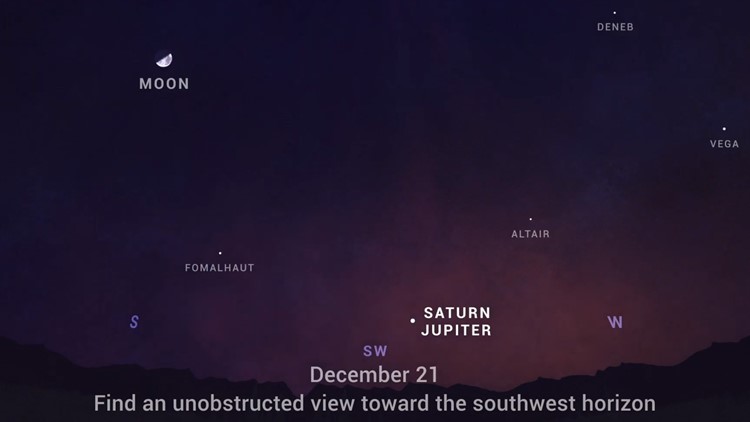COLUMBIA, S.C. — The Great Convergence (GC) of Saturn and Jupiter happens only once every 20 years, so naturally it's going to happen at the end of 2020 -- on the day of the Winter Solstice.
During the GC, the orbits of the Solar System's largest gaseous planets make them appear to converge at the same spot in the sky, even though the planets remain millions of miles apart. At their closest, Jupiter and Saturn, visually, will be only 0.1 degree apart.
Jupiter will be low in the southwest right after dark and will be the brightest object in the night sky, says the team at Melton Memorial Observatory. "This conjunction will be fun to observe even without a telescope because Jupiter and Saturn will be so close together they almost appear as one object."
These two worlds will be visibly closer in our sky than they’ve been since 1226 -- the same year the Francis of Assisi died in Umbria (Italy) and Louis IX is crowned in France.
Should the weather be clear, you can observe the GC without the use of a telescope. However, if you want a closer, clearer look at the spectacle, two of the Midland's largest telescopes will be trained to the sky so you shouldn't miss a thing.
Melton Memorial Observatory: staff from University of South Carolina’s Melton Memorial Observatory (MMO) are setting up a livestream event at Lake Murray Dam at 6 p.m. Friday, Dec. 18. You can watch and ask questions about the event on the MMO Facebook page. Weather permitting, the team from Melton says they will set up again on Monday, Dec. 21.
South Carolina State Museum: The museum’s telescope will be trained for optimum viewing at 8 p.m. Monday, Dec. 21. The plan is to livestream the event live on the SC State Museum’s Facebook page, weather permitting. If the forecast looks bad for Monday, then alternative viewing dates are Sunday, Dec. 20 or Tuesday, Dec. 22, at 6:30 p.m. Follow the SC State Museum’s Facebook page for updates.
The Virtual Telescope: website features the feed from remotely controlled robotic telescopes and will stream The Great Convergence Monday, Dec. 21, at 16:00 UTC (Coordinated Universal Time, or 11 a.m. in South Carolina)
NASA offers these suggestions for those who would like to see this phenomenon for themselves, here’s what to do:
- Find a spot with an unobstructed view of the sky, such as a field or park. Jupiter and Saturn are bright, so they can be seen even from most cities.
- An hour after sunset, look to the southwestern sky. Jupiter will look like a bright star and be easily visible. Saturn will be slightly fainter and will appear slightly above and to the left of Jupiter until December 21, when Jupiter will overtake it and they will reverse positions in the sky.
- The planets can be seen with the unaided eye, but if you have binoculars or a small telescope, you may be able to see Jupiter’s four large moons orbiting the giant planet.



